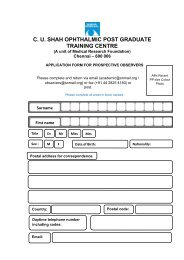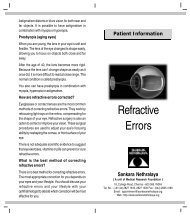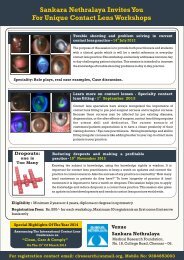Implantable Contact Lens brochure - Sankara Nethralaya
Implantable Contact Lens brochure - Sankara Nethralaya
Implantable Contact Lens brochure - Sankara Nethralaya
You also want an ePaper? Increase the reach of your titles
YUMPU automatically turns print PDFs into web optimized ePapers that Google loves.
Undercorrection : The opposite of overcorrection, undercorrection<br />
is the result of an implantable contact lens with too weak of<br />
a prescription. Correction methods are similar to those of<br />
overcorrection.<br />
Infection : During most surgeries, there is a potential risk of an<br />
infection.<br />
Increased intraocular pressure : Pressure may build in the eye after an<br />
ICL procedure. The sooner a surgeon is alerted to this, the greater the<br />
chance of avoiding serious damage.<br />
This is detected during your follow up visits with us or in case you face<br />
acute blurring of vision or headaches, you must visit the eye clinic.<br />
ICL may rarely need to be repositioned.<br />
Damage to crystalline lens : because implantable contact lenses are<br />
implanted into the eye, there is a potential that the eye’s natural lens<br />
may be damaged during the procedure. If the damage is severe, the<br />
crystalline lens may need to be replaced with an intraocular lens.<br />
Cataract development : Over 50 percent of the population will<br />
develop cataracts by the age of 65, however, it is believed that the use<br />
of some implantable contact lenses may cause cataracts at an earlier<br />
age, this however is rare.<br />
Halos, glare, and double vision : Updated ICL models greatly diminish<br />
the risks of halos, glare, and double vision.<br />
Retinal detachment : Less than 1 percent of patients in the clinical<br />
studies were affected by retinal detachment. It should be noted,<br />
however, that the occurrence of retinal detachment increased as the<br />
degree of myopia increased.<br />
Where is the ICL placed?<br />
A trained ophthalmologist will insert the ICL through as small micro-incison,<br />
placing it inside the eye just behind the iris in front of the eye’s natural lens.<br />
The ICL is designed not to touch any internal eye structures and stay in place<br />
with no special care.<br />
What is Toric ICL?<br />
The Toric ICL is only a variant of ICL. Toric ICL corrects your<br />
nearsightedness as well as your astigmatism (cylindrical power) in one single<br />
procedure. Each lens is custom made to meet the needs of each individual eye.<br />
What is the track record of the ICL?<br />
Prior to being placed on the market, the ICL was subject to extensive research<br />
and development. Today, more than 65,000 patients worldwide enjoy the<br />
benefits of the device. In an USFDA clinical trial, over 99 percent of patients<br />
were satisfied with their implant. The ICL has a track record of stable,<br />
consistently excellent clinical outcomes. The lens has been available<br />
internationally for over 12 years.<br />
Does it hurt?<br />
No, most patients state that they are very comfortable throughout the<br />
procedure. Your ophthalmologist will use a topical anesthetic drop prior to<br />
the procedure and may choose to administer a light sedative as well.<br />
What is the ICL made of ?<br />
The ICL is made of Collamer ®, a highly biocompatible advanced lens material<br />
which contains a small amount of purified collagen. Collamer does not cause a<br />
reaction inside the eye and it contains an ultraviolet filter that provides<br />
protection to the eye. Collamer is a material proprietary to STAAR Surgical<br />
Company, the company that manufactures ICL.<br />
What if my vision changes after I receive the ICL?<br />
One advantage of the ICL is that it offers treatment flexibility. If your vision<br />
changes dramatically after receiving the implant, your doctor can remove and<br />
replace it.<br />
Patients can wear glasses or contact lenses as needed following treatment<br />
with the ICL. The implant does not treat presbyopia (difficulty with reading<br />
in people 40 and older), but you can use reading glasses as needed after<br />
receive the ICL.<br />
What type of procedure is involved in implanting the ICL?<br />
The implantation procedure for the ICL (<strong>Implantable</strong> <strong>Contact</strong> <strong>Lens</strong>) is<br />
refractive eye surgery that involves a procedure similar to the intraocular lens<br />
(IOL) implantation performed during cataract surgery. The main difference is<br />
that, unlike cataract surgery, the ICL eye surgery does not require the<br />
removal of the eye’s natural lens. The ICL procedure is a relatively short<br />
outpatient procedure that involves several important steps. The surgical<br />
procedure to implant the ICL is simple and nearly painless.<br />
As a ICL candidate, your doctor will prepare your eyes one to two weeks<br />
prior to surgery by using laser to create a small opening between the lens and<br />
the front chamber of your eye (iridotomy). This allows fluid to pass between<br />
the two areas, there by avoiding the buildup of intraocular pressure following<br />
the surgery. However, some surgeons choose to do this step on the same day<br />
of the surgery.<br />
The implantation procedure itself takes about 10-15 minutes and is<br />
performed on an outpatient basis, though you will have to make arragements<br />
for someone to drive you to and from the procedure. You can expect to<br />
experience very little discomfort during the ICL implantation. You will<br />
undergo treatment while under a light topical or local anesthetics. Following<br />
surgery, you may use prescription eye drops or oral medication.<br />
The day after surgery, you will return to your doctor for a follow-up visit. You<br />
will also have follow-up visits one month and six months following the<br />
procedure.<br />
Although the ICL requires no special maintenance, you are encouraged<br />
to visit your eye doctor annually for check-ups following the ICL<br />
procedure.<br />
Can the ICL be removed from my eye?<br />
Although the ICL is intended to remain in place permanently, a<br />
certified ophthalmologist can remove the implant in a very quick & short<br />
procedure.<br />
Is the ICL visible to others?<br />
No, the ICL is positioned behind the iris (the colored part of the eye), where it<br />
is invisible to both you and observers. Only your doctor will be able to tell that<br />
vision correction has taken place.<br />
Will be able to feel the ICL once it is in place?<br />
The ICL is designed to be completely unobtrusive after it is put in place. It<br />
stays in position by itself and does not interact with any of the eye’s<br />
structures.<br />
Where can I get my ICL procedure done?<br />
Please be aware that ICL procedure is presently available at selected centre’s<br />
& hospitals in India as it requires precision and skills. In our Institution Cornea<br />
and LASIK experts will guide you better if you are the right candidate for this<br />
procedure.<br />
<strong>Sankara</strong> <strong>Nethralaya</strong> Lasik Centre<br />
41A, A.J.C. Bose Road,<br />
Diamond Prestige Complex, Kolkata - 700 014.<br />
(N/L - Opposite of Nonapukur Tram Depot.)<br />
Ph. : (033) 65461202 / 64991200 / 65461201
















